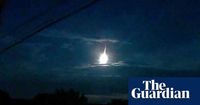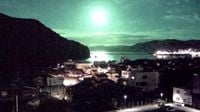On the night of August 19, 2025, residents across western Japan were treated to a celestial spectacle that transformed the ordinary into the extraordinary. An enormous fireball, described by experts as an exceptionally bright meteor, streaked across the sky, briefly turning night into day and leaving a trail of stunned witnesses and scientific intrigue in its wake.
The event unfolded just after 11:00 p.m. local time, when a brilliant ball of light suddenly appeared over southern Japan. According to The Guardian and NHK, the meteor was so luminous that it illuminated entire neighborhoods. Yoshihiko Hamahata, who was driving in Miyazaki prefecture at the time, recounted, "A white light I had never seen before came down from above, and it became so bright that I could clearly see the shapes of the houses around us. It seemed like daylight. For a moment, I didn’t know what had happened and was very surprised." His account echoed the awe and confusion felt by many who witnessed the phenomenon firsthand.
Dashcams and surveillance cameras across Kyushu—the southwesternmost of Japan’s main islands—as well as in major cities like Osaka, Kagoshima, and Kumamoto, captured the fireball’s dramatic descent. Some footage even came from as far east as Osaka’s Kansai Airport, nearly 200 kilometers (124 miles) away, as reported by Space.com. These videos quickly circulated online, with many viewers marveling at how the meteor’s green and blue flashes overwhelmed camera sensors before erupting into a final orange-red flare and breaking apart near the horizon.
Luke Daly, a professor of planetary geoscience at the University of Glasgow, told The Washington Post, "What I saw in the videos were amazing, stunning—a beautiful live show in the sky." Daly explained that fireballs are a special class of meteor, officially defined by NASA as “an unusually bright meteor that reaches a visual magnitude of -3 or brighter when seen at the observer’s zenith.” Such brightness is typically caused by space rocks larger than one meter (three feet) in diameter, which is much bigger than the typical meteors that create fleeting streaks in the night sky.
But this was no ordinary shooting star. Witnesses across the region reported hearing a thunderous boom as the fireball passed overhead, suggesting the space rock was traveling so fast that it broke the sound barrier and created a sonic boom. Daichi Fujii, a fireball expert and curator at the Hiratsuka City Museum, speculated to Asahi Shimbum that the meteor may have been traveling as fast as 21 kilometers per second—nearly 47,000 miles per hour. The shockwaves were so intense that people on the ground could actually feel the air vibrate, adding another sensory layer to the unforgettable event, according to reports from The Guardian and other outlets.
Experts believe the fireball most likely originated from the asteroid belt between Mars and Jupiter. This region of the solar system is teeming with ancient space debris left over from the formation of the planets billions of years ago. When a chunk of this debris, known as a meteoroid, enters Earth’s atmosphere at such incredible speeds, atmospheric friction rapidly heats it up, causing it to burn brightly and sometimes explode—an event technically referred to as a bolide, though the terms “fireball” and “bolide” are often used interchangeably.
There was immediate speculation about whether the fireball was connected to any ongoing meteor showers. As Space.com noted, both the Perseid meteor shower—famous for producing spectacular fireballs—and the weaker kappa Cygnids were active at the time. However, experts cautioned that it’s difficult to determine whether the August 19 event was part of a shower or simply a sporadic meteor, which is a random piece of space debris striking Earth’s atmosphere.
For many, the most dazzling aspect was the meteor’s color. Social media and news footage revealed that the fireball glowed in brilliant shades of green and blue, outshining even the moon and casting eerie, daylight-like shadows across the landscape. According to The Guardian, Toshihisa Maeda, head of the Sendai Space Museum in Kagoshima, confirmed, "It was as bright as the moon." The color and intensity of the light were so pronounced that, as one witness put it, "the night briefly turned to day."
The spectacle reached its climax as the meteor fragmented over the Pacific Ocean, sending out a final burst of light before disappearing from view. Experts, including Maeda and Fujii, agree that the fireball likely plunged into the ocean, dashing hopes of recovering any remnants. This outcome was met with disappointment among scientists, as Luke Daly told The Washington Post that such objects could provide valuable clues about the early solar system and the origins of planets—including our own.
Despite the fleeting nature of the event, its impact was widely felt. Residents from Kyushu to Osaka took to social media to share videos, photos, and personal accounts of the fireball’s passage. Some described feeling the shockwave, while others simply marveled at the beauty and rarity of the moment. The consensus among experts was clear: while the fireball was a natural phenomenon, it was an extraordinary one, a reminder of the dynamic and sometimes unpredictable nature of our solar system.
NASA and local Japanese scientists emphasized that fireballs like this, while rare, are not unheard of. Objects larger than one meter in diameter can occasionally enter Earth’s atmosphere, but most burn up before reaching the ground. In this case, the meteor’s size, speed, and trajectory made it visible for hundreds of miles and ensured that it would be remembered for years to come.
As the dust settles—quite literally—over the Pacific, the August 19 fireball stands as a testament to the power and mystery of the universe. For those lucky enough to witness it, the night sky over Japan will never look quite the same.






